Why would we challenge this seemingly necessary industry?
Are you waking up or falling asleep in darkness? That’s why we believe that we should take a look at what is potentially adding to our lackluster ability to keep our grid functioning, well maintained or just on for a meaningful time period.
Now, as a point of clarification, we are not in any way blaming a certain part of our industry for creating our rolling blackouts, but my goodness they are guzzlers of power, and whilst there have been many announcements of new developments for data centres scattered all over our country, there has only been one announcement of a solar farm planned in the last while, providing 100 MW to our grid. And to be clear, that solar farm would not power one of the large-scale data centre companies we assessed, who would require 190 MW for its network
When the announcements are released, they also include what their power requirements are and to most people this is a number, but we will go through what that number means to you and I. How was this power secured? Is it uninterrupted (national key point) and also that we pay retail price (ESKOM) and in some cases retail plus a margin (municipalities like Joburg Power) and they pay a negotiated wholesale price.
And if these power-hungry users are dealt the same misfortune of being loadshedded, their massive cost to keep the engine turning, or maybe on a different grid that penalises the supplier (ESKOM) if the lights go out.
We also don’t finger any business or call out its leadership, so, on that point, we have named each of our local and international data centre companies.
Read an interesting article about data centres here:

Welcome:
Godzilla (global player)
Bigfoot (local)
Dracula (local)
T-Rex (local hybrid)
Voldemort (all the rest)
What does the current data centre footprint look like in South Africa (including in the ground projects)?
The Africa data centre market size by investment was valued at R30 billion in 2020 and is expected to be R 75 billion by 2026, growing at a compound annual growth rate of 15% during 2021-2026. Insert formula:

The data centre market expects to observe growth because of the flurry of factors:
- • renewable power availability,
- • smart city initiatives, and
- • increased support for the digital economy.
The following factors are likely to contribute to the growth of the Africa data centre market during the forecast period:
- • Availability of Renewable Energy
- • Government Support Boosting Digital Economy
- • Increase in Adoption of All-Flash Storage Solutions
- • Increased Investment in Fiber Connectivity
South Africa Data Centre Market Segmentation
The growth in data generation in Africa is fuelling the demand for fast-processing efficient servers.
The demand for build-to-suit infrastructure is growing to support specific applications. Several segments such as BFSI, healthcare, transportation and logistics, education, and heavy industries adopt advanced server systems for efficient services.
The unreliable power grid connectivity increases the demand for power backup sources. UPS and generator systems are expected to grow due to the increased construction of large and mega data centre facilities.
The data centre scene (colocation) is not a new offering and certainly has no way reached saturation point in South Africa.
You just have to drive along three arterials (N1 JHB-PTA, R24-R21 and R300 (Cape Town)) and within moments you will either see a completed data centre or building works developing a new data centre. Johannesburg, obviously, has the most colocation sites and outsourced data centres in South Africa and then Cape Town with the balance of the country only making up a measly 12% of the data footprint. This allows the providers to capture their clients in the two largest economies but also house a majority of the corporate users.
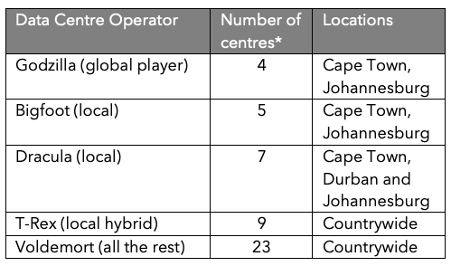
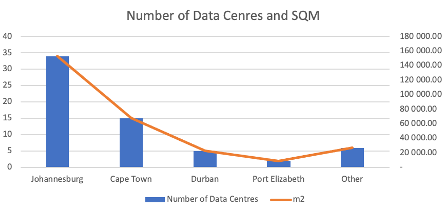
They are thirsty beasts these data centers...
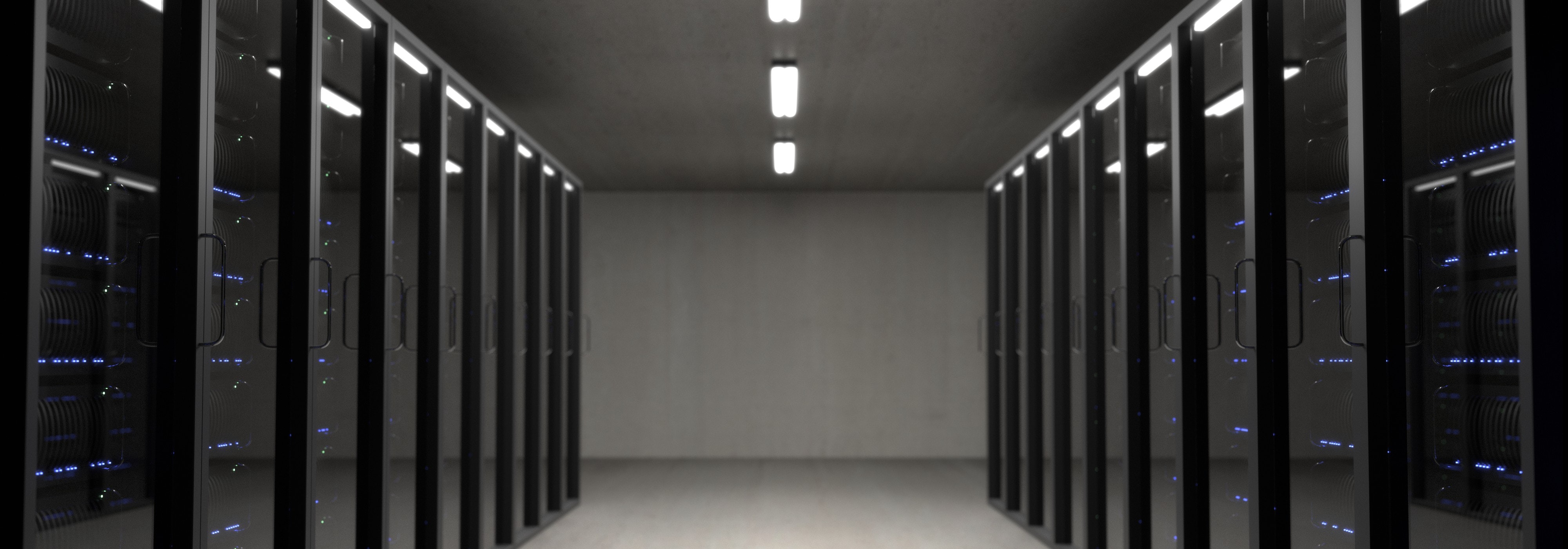
Data centres have for years been known to be excessive consumers of power, representing approximately 10 per cent of the world’s energy and growing to 20% by 2030.
Previously, energy efficiency wouldn’t necessarily be at the top of an information technology (IT) organisation’s priority list, but rising power costs, corporate decarbonisation commitments and an ongoing need for more hardware and equipment as well as booming data consumption is changing the way data centre operators are planning and running their facilities.
Similarly, organisations are becoming more sophisticated in managing energy. While previously, energy was tackled by implementing a number of individual initiatives, it is now common to see well-orchestrated energy strategies with a holistic approach to technology, procurement and implementation.
On the companies that we assessed they require 1.3 Gigawatts of power (that’s 13 of those solar farm developments announced for Northern Cape, and with rough maths that’s a cost of R156 billion).
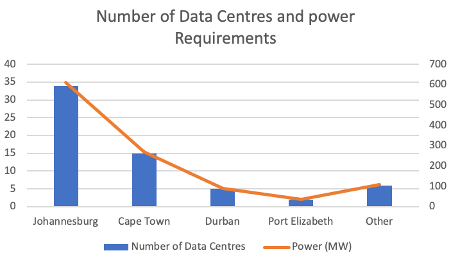
Why do data centres consume so much energy?
Data centres are complex environments that have been created to house IT equipment. Within these, the primary driver of energy consumption is the IT equipment itself. The IT equipment that supports a data centre includes communication systems, storage systems and other IT systems such as processors, server power supplies, network infrastructure and hardware, computers, Uninterrupted Power Supply and connectivity systems.
Most of the energy that is consumed within a data centre needs to pass through various stages of distribution before it can be used by IT systems. This energy is converted to heat, which is why these facilities require a significant amount of cooling.
As server densities continue to rise, cooling systems are under increased pressure to keep IT equipment and servers cool enough for them to operate efficiently. If temperatures or the humidity is too high, IT equipment can be damaged and tape media errors can occur.
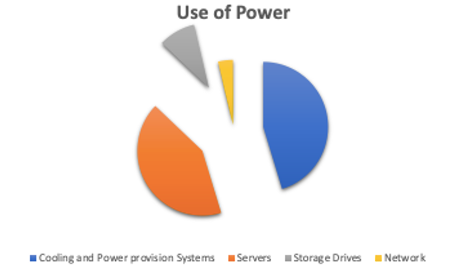
What can data centre developers and operators do to optimise their energy consumption?

Examples of these opportunities are virtualisation and the use of ARM-based processors, which are designed to perform a smaller number of types of computer instructions so that they can operate at a higher speed. This provides outstanding performance at a fraction of the power. The technological development of both these options is making them a viable solution, but they are still outside of the remit of most data centre developers.
Good practical management of data centre space is still a suitable, basic way of reducing energy consumption. Making use of aisle containment systems, installing blanking panels into unused rack slots and providing brushed grommets into raised floor penetrations are all simple, yet effective, energy saving methods that can be implemented, but they are still forgotten in many smaller facilities.
Implementing aggressive power usage effectiveness (PUE) or NABERS Energy targets will also drive more energy saving initiatives and improvements within data centres. New facilities will find it easier to implement PUE targets as high efficiency equipment can be selected to reduce parasitic load requirements.
Implementing low PUE targets, such as energy efficient lighting, in existing facilities is also achievable, but it takes more financial backing and careful planning to realise. When equipment needs to be replaced, more energy efficient options can also be chosen.
Lastly, the application of machine learning for data centres has been used to optimise cooling system setpoints for variable outside conditions. Having optimum setpoints provides a number of marginal energy gains, that when aggregated can provide as much as 10-15 per cent energy savings on the cooling system.
Could more data centres use natural cooling and night cooling opportunities to save energy?
Free cooling opportunities are possible in many locations, especially if the air temperature that is supplied is in line with the American Society of Heating, Refrigerating, and Air-Conditioning Engineers.
With supply air temperatures of up to 27°C, we need outside air temperatures at 25°C or lower to gain significant benefits from free cooling. Data centre managers then need to decide whether they are going to use direct or indirect free cooling. Indirect free cooling can be achieved via a heat wheel or heat exchanger as outside air contaminants or humidity levels do not restrict the use of free cooling, making it an attractive option.

There are definitely more opportunities to use this type of indirect free cooling in certain areas, particularly where the temperature falls below 19°C and the humidity is below 60 RH (relative humidity) for more than 2 500 hours per year.
Gas suppression system can be problematic because enclosed aisles can create an extra layer of infrastructure with the associated costs.
Summary of potential solutions:
- • Data centres consume up to 10 per cent of all global energy production.
- • There are several options to save energy in data centres: virtualisation, ARM based processors, good practical management of facilities and implementing power usage effectiveness (PUE) targets.
- • A well-orchestrated energy strategy is key to success.
- • Cooling systems in data centres are large power guzzlers. Free cooling opportunities exist in many locations – Data centre managers need to decide whether they are going to use direct or indirect free cooling.
- • Data centre managers need to decide whether they are going to use direct or indirect free cooling.
- • Key processing tasks can be scheduled to take place after peak hours to save energy.
- • Future trends in data centre design and development include integrating cost-effective, sustainable energy solutions, including the use of renewables such as solar and wind for energy and seawater for cooling.
Conclusion
We found the poignant quote that describes the data centre offering to our power issues:
“Embracing colocation has an immediate and longstanding positive impact on energy consumption. A company with 100 employees being serviced by an in-house, 30 m2 server room can easily use 80% of their total monthly electrical consumption on this room's power usage. However, our research shows that virtualising four to five servers can result in a 50% - 60% saving in power. Therefore, it doesn’t make sense to upgrade your own facility to counteract higher power usage.” Ex CEO Bigfoot
So the industry is in fact a power GUZZLER, if we all jumped ship and collocated our data infrastructure into these centres, we would not only be helping our variable OPEX line but we would never have to say these words again:
“Sorry MR client, but due to load shedding, our server is down so will get you that quote in the next few hours”
Well not 99.768% of the time anyway…
And watch this space because the announcement that allows industry to produce upwards of 100mw of power will see an influx of companies and industries self-generating its power requirements, the data centre businesses included.
White Boxing SA
082 938 4795
admin@whiteboxingsa.co.za
www.whiteboxingsa.co.za

